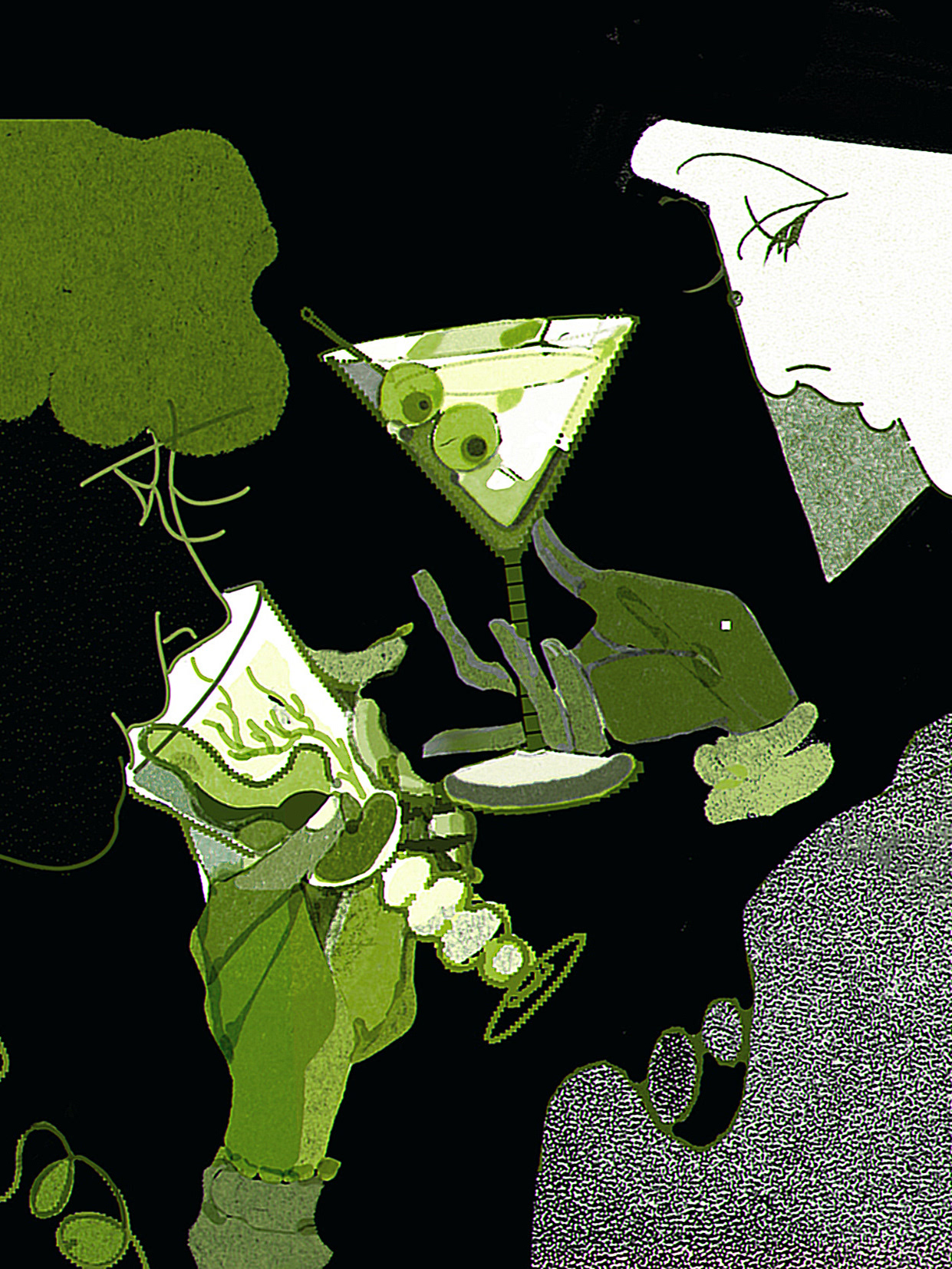The Restorative Power of Secret Food Rituals,
By Virginia Sole-Smith
Editorial Illustration
2021
Digital Art, Gif
The Restorative Power of Secret Food Rituals
For parents like me, it’s sushi in my car for 15 blissful minutes — and here’s why that’s OK.
By Virginia Sole-Smith
Here’s how I’ve gotten through 2020: Every week when I do my family’s grocery shopping, right before I check out, I swing by the store’s sushi counter and pick up one salmon avocado roll and one spicy tuna roll. Sometimes they don’t have spicy tuna rolls. But the sushi guy knows me, so he just nods over his mask and I nod over my mask, and then I go grab a Diet Coke while he makes me a fresh roll. After I pay, I put the groceries in the trunk of my car, douse myself in hand sanitizer and take the sushi and Diet Coke into the front seat. I lock the doors, put on a podcast, and for 15 blissful minutes, I eat my sushi, alone in my car in the grocery store parking lot. And it is heaven.
Back in the carefree Before Times, I’d occasionally pick up sushi if I shopped on my lunch break. But back then, I could go to a restaurant for sushi, or any other kind of food made by somebody other than me, any time I wanted. My husband and I could book a babysitter for a Saturday night and eat whole meals in places that were not our home, with people who were not our children. The kids did not spend so much time in our direct care, and I was not fielding their endless snack requests (Links to an external site.).
Now, I often need to plot an escape. And if you are a fellow “pandemic parent,” trying to hold onto some semblance of yourself amid the chaos and claustrophobia of this year, let me recommend that you find yourself a secret food ritual, too.
It does not matter what the food is, as long as you love it and can find a time to eat it all by yourself. If you can leave your house to do it, even better, but it is absolutely acceptable to hide in your pantry and eat saltine crackers covered in strawberry jelly, which is what Cheryl Lock in Arvada, Colo., does so she doesn’t have to share them with her daughters, ages 2 and 4.
Candace Jackson, mom to a 4-year-old and 17-month-old in Oakland, Calif., waits until her kids have gone to bed and then makes a small chocolate cake (Links to an external site.) using her microwave and a coffee mug. “I always make it in the same black Powell’s bookstore coffee mug,” she said. “As soon as I pull that mug out, my husband just looks at me like, ‘Rough day?’” And Jennifer Toone, a mom of six in Elk Grove, Calif., said she keeps a stash of dark chocolate peanut butter cups in her top dresser drawer so she can tell her family she’s going upstairs to “use the bathroom” and then sit on her bed with her treats “for as long as I can get away with it.”
That secret “getting away with it” part is essential. I see all of you out-in-the-open foodies, with your performative sourdough baking. And I respect the strategy: You survive by becoming immersed in a complicated kitchen task that can be executed only if you’re ignoring everyone around you. But that kind of ritual requires messing up the kitchen and demands a level of energy I cannot summon right now. I need the exquisite hidden stillness of car sushi; the reliability of those tidy plastic containers and the ability to throw all the evidence in the trash as soon as I’m done. Nobody needs to know. They can just appreciate that I come home in a better mood.
But let’s be clear that car sushi, or coffee mug cake, or any other such covert indulgence is not a sign of disordered eating, according to the experts I consulted. “You’re aware that you are overwhelmed and you’re actively taking care of yourself,” explained Christyna Johnson, a dietitian who specializes in eating disorder treatment in Dallas. “You might be eating and using that time to process your feelings.” Which doesn’t mean you solve anything, or even stop feeling angry or sad. “Maybe this is a temporary place holder — something that lets you release a little steam, and sit with tough emotions just enough so that you can keep functioning,” Johnson said.
This is quite different from the self-destructive sort of secret eating that is the hallmark of a more disordered relationship with food. “If you’re not aware of your emotional experience while eating or even afterwards find that you cannot tap into your feelings, then that’s not helpful,” Johnson said.
It’s also important to consider whether your secret food is a food you would eat at other times (and just happen to enjoy most when you’re alone), or if you otherwise see it as forbidden. “If you’re only allowing yourself to eat this food in secret, then it’s an unhelpful coping mechanism because you don’t have full permission to eat that food whenever you want,” Johnson said. “The euphoria you’re feeling from eating it is clouding your nervous system’s ability to calm down. And it’s likely to be replaced by shame afterwards.”
There is a gray area where you may enjoy eating the food, but then feel a sort of obligatory shame afterward because of the way our culture programs us to apologize for eating. But you can start to let that go by embracing the restorative power of secret comfort eating. “It’s accessible and immediately gratifying,” said Molly Robson, a nutrition consultant and mom of a 7-year-old in Boston. “We can do all the yoga, gardening and meditation we want, but at the end of the day, comfort eating works.”
Robson’s secret eating ritual of choice is, like mine, grocery store-based: “I like to pick up this little box of popcorn chicken with honey mustard sauce and eat it while I drive home,” she said. “Having something that’s just for you — even if it’s just food — is very important right now.”
Let’s also make the distinction between saving something delicious “just for you” and not allowing your kids to have the treats you allow yourself. As I’ve reported previously, restricting kids’ intake of sugar (or any favorite food) can backfire (Links to an external site.) and make them fixate further on it. So just as you should give yourself full permission to eat this secret food anytime you like, you should also lift the veil of secrecy and share it with them from time to time, especially if it’s a treat they enjoy. As Robson said, “Comfort eating should be a part of your kids’ life too.”
It’s not necessary to share all the good stuff, though. “You don’t have to give them your favorite fancy ice cream if it’s just going to end up melted in the bowl,” Johnson said. I learned this lesson last week when I brought my grocery store sushi home to eat with my family for a change. The 3-year-old stole half of my salmon avocado roll, leaving a decimated pile of rice in her wake. When we eat sushi together again, she’ll get her own roll. But anyway, that’s just a family meal. It can never replace my car sushi.









